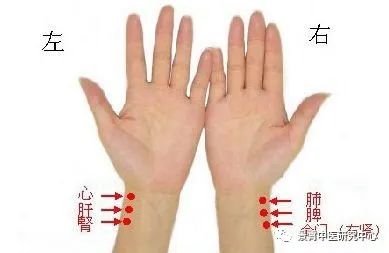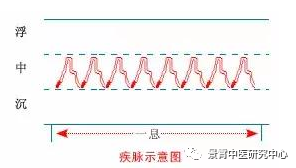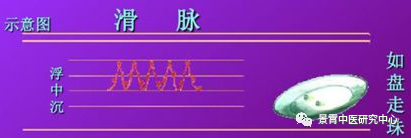Pulse diagnosis (mài zhěn) is a method of examining the pulse at various points on the body to observe changes in the pulse pattern. It is also known as pulse palpation (qiè mài), pulse examination (zhěn mài), pulse pressing (àn mài), and pulse holding (chí mài). The formation of pulse patterns is closely related to the qi and blood of the organs. If there are pathological changes in the organs’ qi and blood, the circulation of blood will be affected, leading to changes in the pulse pattern.

Steps of Pulse Diagnosis:
First distinguish floating and sinking, second differentiate deficiency and excess;Third assess length and shortness, fourth calculate rapidity and slowness;Fifth observe the pulse shape, know them all.
1. What is “First distinguish floating and sinking”?
① First, distinguish whether the pulse is floating (fú mài) or sinking (chén mài). When palpating the pulse, the fingers gradually probe from the superficial to the deeper layers. Initially, lightly touch the skin (i.e., “jǔ”) to determine if the pulse is floating; if there is no floating pulse, apply more pressure (i.e., “xún”) to feel various pulse patterns at this level; then apply a third level of pressure (i.e., “àn”) to check for a sinking pulse. Thus, “First distinguish floating and sinking” refers to the sequence of pressure applied to detect the position of the pulse pattern.
② In distinguishing between floating and sinking, one can identify the types of pulse patterns related to floating and sinking, which are:Floating pulse types—floating pulse (fú mài), moist pulse (rú mài), leather pulse (gé mài), hollow pulse (kāo mài), scattered pulse (sàn mài);Sinking pulse types—sinking pulse (chén mài), firm pulse (láo mài), hidden pulse (fú mài).
③ Distinguishing between floating and sinking pulse types can indicate whether the condition is an exterior syndrome (biǎo zhèng) or an interior syndrome (lǐ zhèng).
2. What is “Second differentiate deficiency and excess”?
① After distinguishing between floating and sinking, it is essential to understand the relationship between the righteous qi (zhèng qì) and pathogenic qi (xié qì) (deficiency syndrome (xū zhèng) or excess syndrome (shí zhèng)). The distinction between deficiency and excess in pulse patterns is represented by weak pulse (xū mài) and strong pulse (shí mài).Thus, the second step in pulse examination is to differentiate between deficiency and excess (strength and weakness).
② In distinguishing the pulse as deficient or excess (i.e., strong or weak), one can also identify other pulse patterns related to deficiency and excess. Deficient pulse types—weak pulse (xū mài), faint pulse (wēi mài), soft pulse (ruǎn mài); excess pulse types—strong pulse (shí mài).
3. What is “Third assess length and shortness”?
① Long pulse (cháng mài) and short pulse (duǎn mài) are two types of pulse patterns with very distinct characteristics, which can be distinguished by touching the pulse vessel with the fingers.
② When examining the cun (cùn), guan (guān), and chi (chǐ) positions, first distinguish between long and short pulses, and then further examine the pulse patterns at these positions.
③ While distinguishing between long and short pulses, one can also observe other related pulse patterns, such as: long pulse types—long pulse (cháng mài), string-like pulse (xián mài), thin pulse (xì mài); short pulse types—short pulse (duǎn mài).
4. What is “Fourth calculate rapidity and slowness”?
① After determining the pulse position (the pulse position distinguishes length and string-like characteristics, while observing floating and sinking) and pulse quality (which also includes deficiency and excess), the next step is to assess the frequency and rhythm of the pulse.
② There are eight pulse patterns related to pulse frequency and rhythm: pulse rate—rapid pulse (shù mài), swift pulse (jí mài), slow pulse (chí mài), and moderate pulse (huǎn mài); pulse rhythm—hurried pulse (cù mài), knotted pulse (jié mài), intermittent pulse (dài mài), and scattered pulse (sàn mài).
5. What is “Fifth observe the pulse shape”?
① After completing the above four steps, one can distinguish 23 types of pulse patterns. The remaining four pulse patterns are primarily characterized by their shape: surging pulse (hóng mài), slippery pulse (huá mài), rough pulse (sè mài), and tight pulse (jǐn mài).
② Except for the unique surging pulse, slippery and rough pulses are opposites, while tight and rough pulses are distinguished from each other. The surging pulse often appears in summer or during febrile diseases (yangming heat (yángmíng rè shèng) or warm disease (wēn bìng) in the qi stage), or in the final stages of critical illness, which can be inferred from other information.
6. What is “All are known”?
① This is the final review stage. By this point, one should have a clear understanding of the pulse position (left and right, up and down), pulse quality (deficiency and excess), pulse rate (rapid and slow), pulse rhythm (knotted and intermittent), and pulse shape (surging, tight, slippery, rough), no longer feeling “unclear under the fingers, difficult to understand in the heart”.
② All information should be integrated and analyzed to draw conclusions.
The method for drawing conclusions is:
A: Filter all pulse information through the definitions of 28 pulse patterns in the mind, using independent pulse names where applicable; otherwise, use combined pulse methods to define the pulse pattern.
B: Examine the degree of consistency between the obtained pulse pattern and the information obtained from observation, listening, questioning, and diagnosis, then determine the authenticity of the pulse pattern and its relevance to treatment decisions.
C: Carefully examine the cun, guan, and chi positions when the condition is complex, the cause is unclear, or the location is unknown; otherwise, they can be examined collectively.
Basic Theory of Pulse Diagnosis
The significance of pulse diagnosis: Pulse diagnosis is an indispensable step and content in TCM clinical practice. The importance of pulse diagnosis lies in its ability to convey physiological and pathological information from various parts of the body, serving as a window to observe internal functional changes and providing important evidence for diagnosing diseases.
In summary, the following points can be made:
① Distinguish the location of the disease: For example, floating pulse indicates an exterior syndrome, while sinking pulse indicates an interior syndrome.
② Distinguish the nature of the disease: For example, slow pulse and tight pulse indicate cold, while rapid pulse and slippery pulse indicate heat.
③ Distinguish the strength and weakness of the righteous and pathogenic qi: For example, weak pulse indicates deficiency of righteous qi, while strong pulse indicates excess of pathogenic qi.
④ Distinguish the progression or regression of the disease: For example, in external febrile diseases, as the heat gradually recedes, the pulse pattern becomes more moderate, indicating recovery.

Normal Pulse Patterns: Stomach, Spirit, Root In TCM theory, normal pulse patterns can be summarized with the three characters: stomach (wèi), spirit (shén), and root (gēn). The characteristics of normal pulse patterns are: pulses are present in all three positions (cùn, guān, chǐ), neither floating nor sinking, neither fast nor slow, with a frequency of 4-5 beats per breath, equivalent to 72-80 beats per minute (for adults), neither large nor small, calm and gentle, with a consistent rhythm. The pulse at the chi position should have a certain strength and varies according to physiological activities, climate, seasons, and environmental changes.
Pathological Pulse Pattern Analysis

Floating Pulse: Lightly pressing reveals presence, pressing harder reveals absence; floating pulse drifts lightly on the flesh, like a boat floating on water, the floating pulse can be carefully examined, strong against wind indicates exterior excess, weak and lacking spirit indicates floating deficiency, with seven variations (floating tight, floating slow, floating slippery, floating rapid, floating slow, floating deficient, floating surging), among which rationality must be experienced.
Surging Pulse: Surging pulse fills the fingers like waves, strong upon arrival and natural upon departure. Surging pulse indicates yang excess, especially in summer, not necessarily indicating fire excess.

Excess Pulse: Excess pulse is strong and robust, indicating the strongest force; new diseases indicate fire excess, while chronic diseases indicate qi pain.

Long Pulse: Long pulse extends beyond its original position, resembling a long rod, strong qi in the heart and kidneys, connected to the strong qi of the body, resembling a sword.

Short Pulse: Short pulse resembles a turtle, with the head hidden and the tail exposed; the pulse in the cun and chi positions can be relied upon, while the guan position may not be examined; rough and slightly moving indicates difficulty in treatment, resembling a significant loss of true essence.

Hollow Pulse: Both sides are solid, with a hollow center; hollow pulse feels soft like scallions, with the floating yang seen in the hollow blood rising; hollow pulse appears late, flowing red below; hollow pulse is lightly examined, floating pulse indicates damage to qi and blood, leading to spontaneous sweating and deep bone steaming.

Scattered Pulse: Scattered pulse appears floating without sinking; it feels irregular and scattered, like a boat drifting; pressing it reveals difficulty in returning to order; it indicates early miscarriage, and if the pulse is scattered for a long time, it may lead to death.

Sinking Pulse: Sinking pulse feels heavy against the fingers, like a stone sinking in water; pressing reveals weakness, indicating true essence weakness; strong pressure indicates pain and stagnation of qi; in cold conditions, the pulse is uniformly sinking, with variations such as sinking tight, sinking slippery, sinking string-like, sinking thin, sinking rapid, sinking slow, sinking faint; do not confuse the rapidity of the pulse.

Faint Pulse: Faint pulse is extremely thin, like a string; sinking and extremely thin indicates a continuous pulse; it is not suitable for the young in spring and summer, but is suitable for the elderly in spring and winter.

Hidden Pulse: Hidden pulse is deep and floating, requiring pressure to feel; true qi is not circulating, indicating stagnation; the pulse does not rise to the surface.

Weak Pulse: Weak pulse feels soft and fluffy, lightly pressing reveals no strength; it indicates depletion of essence and blood; the young should be cautious of premature graying.

Deficient Pulse: Deficient pulse feels soft and large, pressing reveals weakness and hollowness; it indicates damage to spirit, qi, and blood, with the cause being deficiency, leading to excessive sweating.

Firm Pulse: Firm pulse is deep and strong, indicating significant force; it is long and solid, indicating slight illness and true essence loss, with symptoms such as shortness of breath and abdominal hernia.

Leather Pulse: Leather pulse feels floating and urgent, resembling a drum skin; it indicates postpartum hemorrhage in women and blood deficiency or “dream emission” in men.

Slow Pulse: Slow pulse indicates a very slow return, with a frequency of three; it is very slow and slightly delayed; floating slow indicates an exterior cold syndrome, while sinking slow indicates an interior cold syndrome. Moderate, knotted, intermittent, and rough pulses belong to the slow category; do not discuss lightly without thorough examination.

Moderate Pulse: Moderate pulse is even and not biased, like a gentle breeze swaying willows; to seek spirit and qi from the pulse, it lies in calmness and moderation; moderate and slow indicate damage to qi and blood, while calmness indicates stability of qi.

Knotted Pulse: Knotted pulse indicates a return after a pause; it is recorded in the body; sadness and worry can lead to stagnation, while five hollow pulses can lead to distension.(Five hollows: qi, blood, phlegm, fluids, food)

Intermittent Pulse: Intermittent pulse is difficult to detect; it takes a long time to return, indicating severe qi deficiency; it is associated with pregnancy and survival.

Rough Pulse: Rough pulse is difficult to smooth out, with fine, slow, short, and scattered characteristics; it indicates stagnation and difficulty in treatment, leading to damage to blood and essence.

Rapid Pulse: Rapid pulse indicates a quick return, with a frequency of six; it indicates yang heat; one must treat deficiency with cooling and excess with warming; rapid pulse is to be feared in lung diseases in autumn. Urgent, tight, string-like, slippery, moving, and hurried pulses are all arranged under rapid pulse.

Swift Pulse: Swift pulse is faster than rapid pulse, indicating yang and can signify danger.

Tight Pulse: Tight pulse is rapid and string-like, resembling a twisted rope; floating tight indicates cold and body pain, while sinking tight indicates abdominal pain.

String-like Pulse: String-like pulse feels firm and straight, like a string; it indicates the severity of the disease based on the softness or hardness felt at the pulse.

Slippery Pulse: Slippery pulse rolls like pearls, flowing smoothly; it indicates stagnation of phlegm and qi in the chest, while in women, it indicates pregnancy.

Moving Pulse: Moving pulse feels irregular and is difficult to locate; it indicates anxiety and emptiness of the heart, with sweating and fever indicating imbalance of yin and yang.

Hurried Pulse: Hurried pulse indicates rapid and irregular beats; it is associated with five types of stagnation: blood, qi, phlegm, food, and fluids.

Moist Pulse: Moist pulse feels weak and empty; it indicates blood deficiency and yang deficiency, with excessive sweating at night and bone heat.
Pulse verification is like a clear mirror; scholars who study diligently will master it.
Jingxiao Professional Training
Click the mini-program above to learn more about TCM knowledge.

